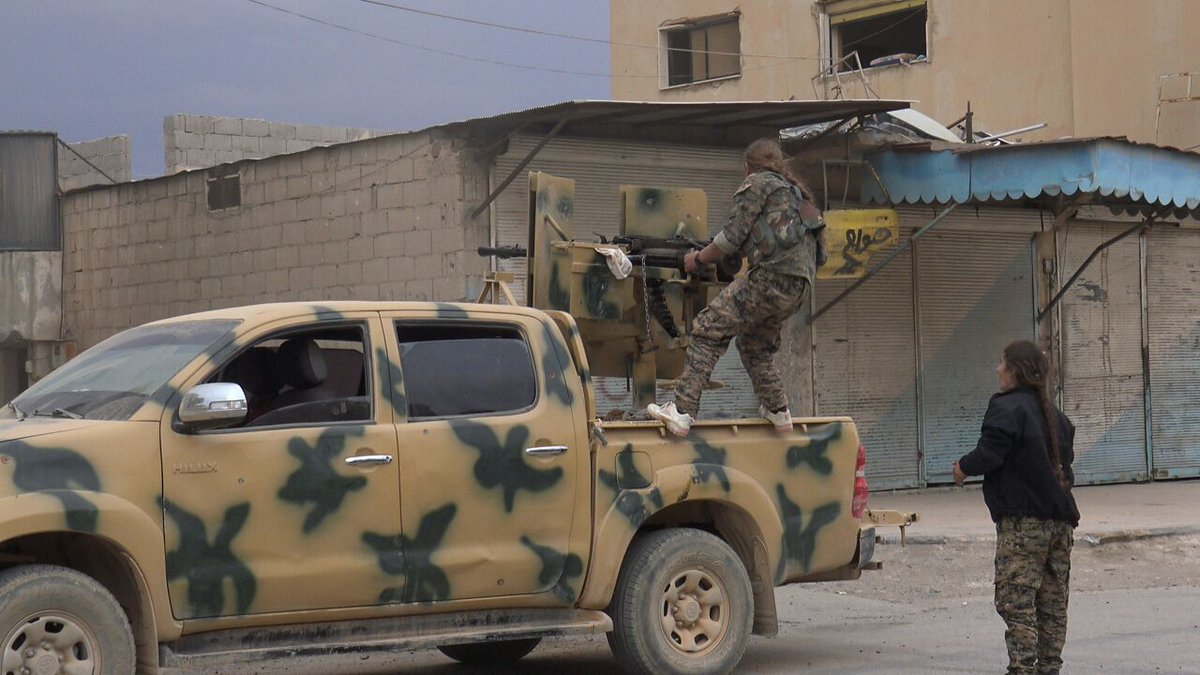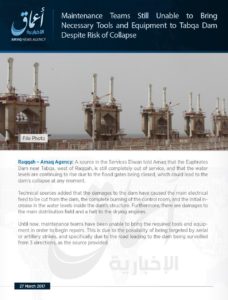
US-backed forces have liberated the city of Tabqah, the Tabqah Dam and an airfield from the Islamic State, according to Central Command (CENTCOM) and Combined Joint Task Force – Operation Inherent Resolve (CJTF-OIR).
The operations were “completed” yesterday (May 10) with the surrender of Islamic State fighters in the area.
The Syrian Arab Coalition (SAC) and Syrian Democratic Forces (SDF) were responsible for the bulk of the fighting.
“This is yet another victory by the SAC and the SDF, our most committed and capable ground force partners in the fight against ISIS who remain hard at work erasing ISIS from the battlefield, liberating their own people and lands,” CJTF-OIR spokesman Col. John Dorrian said in a statement.
The battle for Tabqah is a key part of the US strategy for taking the Islamic State’s capital in Raqqa, which is less than 30 miles away. Kurdish and other Arab fighters are pressuring Raqqa from multiple sides in anticipation of a coming assault on the city.
The offensive on Tabqah began on Mar. 22 with “a surprise aerial infiltration behind enemy lines to the south of Lake Assad,” according to CENTCOM.
The US military credits the “multi-ethnic” SDF with increasing “pressure” on the Islamic State “from each flank,” thereby accelerating “the pace of the fight,” clearing “the final neighborhoods of the city,” and isolating Tabqah Dam before the jihadists were finally forced to surrender.
“Approximately 70 ISIS fighters conceded to the SDF’s terms, which included the dismantling of IEDs surrounding the dam, the surrender of all ISIS heavy weapons, and the forced withdrawal of all remaining fighters from Tabqah City,” CENTCOM’s statement reads.
Senior Islamic State leaders and foreign fighters relocated to Tabqah
Over the course of the past year, the so-called caliphate had moved key leaders, foreign fighters and operatives responsible for planning attacks abroad to Tabqah. The US military says the Islamic State had used the city as a “a key coordination hub” to “plan local operations and external attacks against the West” since 2013. Additional “foreign fighters and external attack planning” operatives were moved to the area after the Islamic State suffered losses in northern Syria. The group was hoping to keep these jihadists safe from the coalition’s airstrikes, but a number of them were hunted down.
CJTF-OIR announced late last year that Abu Jandal al-Kuwaiti, a former member of the Islamic State’s “War Committee,” was killed in an airstrike near Tabqah Dam on Dec. 26.
Kuwaiti had been “involved” in the group’s “retaking of Palmyra” from Bashar al Assad’s forces “before being reassigned to Tabqah to try to improve” the Islamic State’s “defenses” against the SDF. Kuwaiti “was involved in the use of suicide vehicles, IEDs and chemical weapons against the SDF.” CJTF-OIR assessed that his death would “degrade” the organization’s defense of Raqqa, as well as the jihadists’ ability to “launch external operations against the West.”
The Islamic State’s Rumiyah (“Rome”) magazine reported earlier this year that one of the group’s chief propagandists, Ahmad Abousamra (also known as Abu Sulayman al Shami), was killed in an airstrike near Tabqah in January.
Abousamra, a US citizen who was long wanted by the FBI, rose through the Islamic State’s media ranks to become the chief editor of Dabiq, an English-language online magazine that frequently called for attacks in the West. Rumiyah is the successor publication to Dabiq. Abousamra was also a key player in the Islamic State’s rivalry with al Qaeda. [See FDD’s Long War Journal report: How a US citizen became a key player in the Islamic State’s rivalry with al Qaeda.]
Another senior Islamic State figure, Tarkhan Tayumurazovich Batirashvili (also known as Abu Omar al Shishani), oversaw an Islamic State prison in Tabqah for a time. The facility may have “held foreign hostages,” according to the US Treasury Department.
Batirashvili served as one of Abu Bakr al Baghdadi’s most senior military commanders. In mid-2013, he was appointed the head of the so-called caliphate’s forces in northern Syria, including Raqqa province. He oversaw the forces that battled Bashar al Assad’s regime for control of the Tabqah military airbase in 2014. Batirashvili was killed south of Mosul, Iraq last July.
Possible “humanitarian disaster” averted

On Mar. 27, just days after the surprise assault on Tabqah, the Islamic State’s Amaq News Agency released an alarming statement. It was titled, “Maintenance Teams Still Unable to Bring Necessary Tools and Equipment to Tabqah Dam Despite Risk of Collapse.” Amaq alleged that the dam was “completely out of service” due to airstrikes and “water levels are continuing to rise due to flood gates being closed, which could lead to the dam’s collapse at any moment.” Amaq also published photos depicting the damage supposedly done to the dam’s control room by coalition bombings.
The dam didn’t collapse, and Amaq may have been exaggerating.
But CENTCOM says the capture of the dam “prevented a potential humanitarian disaster and ensured local citizens will continue to receive the dam’s basic services.” CENTCOM adds that the SDF accepted the Islamic State’s “surrender of the city to protect innocent civilians and to protect the Tabqah dam infrastructure which hundreds of thousands of Syrians rely on for water, agriculture, and electricity.”
Partner forces make up main ground force
US military officials are trumpeting the fall of Tabqah as further evidence of the efficacy of America’s battlefield partners.
“The SDF’s success against ISIS demonstrates the power of working by, with and through local partner forces fighting ISIS, among their own people, in their own territory,” Col. Dorrian, the CJTF-OIR spokesman, said. “The SDF, fighting to liberate their own people and lands, have freed more than 8,000 square kilometers of Syria from ISIS since November.”
But America’s choice of allies has not been without controversy.
The Kurdish YPG (or People’s Defense Units) is part of the American-backed SDF. The YPG and its female brigade, the YPJ (or Women’s Protection Units), are affiliated with the Kurdistan Workers Party (PKK), which has been designated as a terrorist organization by the US government. Turkey objects to the partnership, as the PKK is opposed to the Turkish government. US officials argue that the YPG is distinct from the PKK. But that line is not at all clear. Even Col. Dorrian slipped up earlier this month by referring to the PKK, when he meant the YPG. The US has downplayed this complication because the YPG has long been on the frontline in the battle against the Islamic State’s jihadists.
The YPG advertised its role in the battle for Tabqah on its official website and social media. Some of the video clips and pictures show the YPJ’s female fighters patrolling streets, a YPG flag being raised in the area, and residents celebrating the jihadists’ expulsion.
The Islamic State captured the Taqbah military airbase from forces loyal to Bashar al Assad in Aug. 2014. The fall of the airbase consolidated the group’s grip on the province of Raqqa. The third edition of Abousamra’s Dabiq magazine, released in Sept. 2014, celebrated the “major conquest.” Dabiq bragged that with the fall of the airbase, Raqqa had become the first “wilayah” to be “completely rid of the Nusayrī army” – a derogatory reference to Assad’s forces. One graphic image showed Assad’s soldiers being shot in the head from behind. Another photo showed the corpse of an Assad regime “officer” who had allegedly “boasted on television of false victories.”
The Syrian regime and Russia bombed Islamic State fighters in the area as recently as last year. In June 2016, Amaq released a video purporting to show Russia’s use of cluster bombs during airstrikes on Tabqah city. Amaq also claimed that Assad’s fighters had suffered casualties south of Tabqah at the Thawrah oilfield.
But ultimately it wasn’t the Syrian regime, which suffers from manpower shortages, or its Russian ally that ejected the Islamic State from the area. That was left to American-backed forces.








3 Comments
The Yanks can claim anything but everything is a mess created by them and their policies. Even if Isis is expunged from Syria, then what happens?
For casual readers, Tabqah is a couple hours down Route 4 to the west from Raqqah. On the south shore of Lake Assad.
This “caliphate” is falling apart and a federation of perhaps a dozen sections of Syria looks doable going forward, once DAESH, al Qaeda and their foreign financial support are removed from the picture. Expect the resulting government to be secular on the Ba’athist Model as with the former regime and with Sisis’s Egypt.
Hold. Then Build. It worked in Iraq.